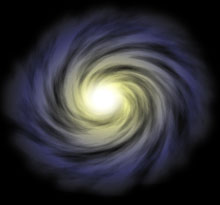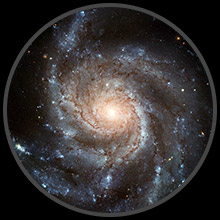

Galaxies are defined as large groupings of stars, dust, and gas held together by gravity. They vary greatly in size and shape. Most of the objects we know of in space are contained within galaxies. They contain stars, planets, moons, comets, asteroids, nebulae, dust, neutron stars, and black holes. Many probably even contain large amounts of unseen dark matter. Since most of the space between galaxies is thought to be empty, a galaxy is essentially an oasis in space. Our own solar system is located within a galaxy. Our Sun is only one of over 100 billion stars in a galaxy called the Milky Way. The Milky Way is a gigantic spiral disk with a bright, central bulge. Our solar system is located about 3/4 of the way out from the center in one of the galaxy's spiral arms. All of the stars we see in the night sky are part of the Milky Way. And just like our solar system, our galaxy is in motion. The stars within the Milky Way revolve around the central core. The Milky Way itself is moving as well. In fact, all of the galaxies in the universe seem to be moving away from each other at tremendous speeds. After studying galaxies for many years, astronomer Edwin Hubble decided to classify galaxies according to their shape. This classification system is known as the Hubble Sequence. It divides galaxies into three main classes with a few variations. Today, galaxies are divided into four main groups: spiral, barred spiral, elliptical, and irregular.
Spiral Galaxy - Spiral galaxies are characterized by a distinct flattened spiral disk with a bright center called the nucleus. Our own Milky Way is a spiral galaxy. Spiral galaxies are represented by the letter S and are divided into four subgroups. These are S0, Sa, Sb, and Sc. S0 galaxies have a bright nucleus but have no spiral arms. Sa galaxies have spiral arms that are wound tightly around the nucleus while the arms of Sc galaxies are wound much more loosely. |
 |
Barred Spiral Galaxy - A barred spiral galaxy is very similar to a spiral with one important difference. The arms spiral out from a straight bar of stars instead of from the center. About one third of all spiral galaxies are barred spiral in shape. Barred spiral galaxies are represented by the letters SB and are arranges into three subgroups according to the openness of the arms. These subgroups are labeled SBa, SBb, and SBc. SBa galaxies have a short bar of stars extending from the center while SBc galaxies have a long, well-defined bar. Our own Milky Way galaxy is now believed to be a barred spiral galaxy. |
 |
Elliptical Galaxy - Elliptical galaxies vary in shape from completely round to extremely elongated ovals. Unlike spiral galaxies, they have no bright nucleus at their center. Elliptical galaxies are represented by the letter E and are divided into seven subgroups according to their shape. These subgroups are labeled E0 to E7. E0 galaxies nearly circular in shape while E7 galaxies are extremely elongated or stretched out. |
 |
Irregular Galaxy - A fourth type of galaxy is known as the irregular galaxy. These galaxies have no discernible shape or structure. Irregular galaxies are divided into two classes, Im and IO. Im class galaxies are the most common and show just a hint of structure. Sometimes the faint remnants of spiral arms can be seen. IO class galaxies are completely chaotic in form. The large and small Magellanic Clouds are examples of Im class irregular galaxies. |
 |
Astronomers have recently been working on a massive project to plot the locations of millions of galaxies in the universe. They are hoping to get a better picture of the overall shape and structure of the universe on the large scale. The sheer size of the universe is difficult for most people to understand. Our galaxy alone is composed of over 100 billion stars. And there are billions of galaxies in the universe. The farthest galaxies discovered are so far away it takes their light nearly ten billion years to reach the Earth. We have discovered that most galaxies are part of a group called a cluster. Our Milky Way is part of a group of about 40 galaxies known as the Local Group. Most clusters tend to be part of a larger grouping called a supercluster. The local group is part of a larger supercluster called the Virgo cluster. This massive cluster contains over 2000 member galaxies. As astronomers begin to map the locations of these galaxies, a grand structure is beginning to take shape. What once appeared to be a random distribution of galaxies is now revealing itself to be a complicated design. Galaxies seem to be grouped together in what appears to be a very complex sponge-like arrangement. The large galactic superclusters are gathered around what appears to be giant voids or bubbles. Nobody knows why this structure exists. We also do not know what, if anything, might exist inside these voids. They could be largely composed empty space or they could be filled with some type of exotic dark matter. It may be some time before we can fully understand the mechanics behind this grand design.

Edwin Hubble was the first person to figure out how to tell the distance of a galaxy. He used a type of pulsating star known as a Cepheid variable as a kind of galactic yardstick. Hubble noticed a correlation between the period required to complete one pulsation brightness and the amount of energy the star gives off. This was the first major breakthrough in galactic research. Hubble also discovered that there was a correlation between the red shift of a galaxy and its distance. This is known today as the Hubble constant. Today astronomers are able to measure the speed and distance of a galaxy by measuring the amount of redshift in its spectrum. We know that all galaxies are moving away from each other. The farther a galaxy is from us, the faster it is moving. To visualize this idea, imagine yourself driving on a highway at 50 miles an hour. The car in front of you is moving away from you at 50 miles an hour, which means that it is traveling at 100 miles an hour. Another car in front of the first car is moving away from it at 50 miles an hour. Though all three cars are moving away from each other at 50 miles per hour, the front car is actually moving away from you at 100 miles per hour. Since redshift shows the speed at which a galaxy is moving away from us, the greater the redshift, the faster the galaxy is moving and the farther it is from us. We now have new tools that are helping astronomers in their search for new galaxies. The Hubble space telescope has opened our eyes to sights never before seen by human eyes. The extreme clarity of Hubble allows astronomers to see fine details in nearby galaxies and to detect distant galaxies that were previously unknown. New tools currently under development will help us obtain a better understanding of the overall structure of the universe.
Stars | Planets | Moons | Asteroids-Comets | Nebulae | Star Clusters
Galaxies | Pulsars | Quasars | Black Holes | Dark Matter